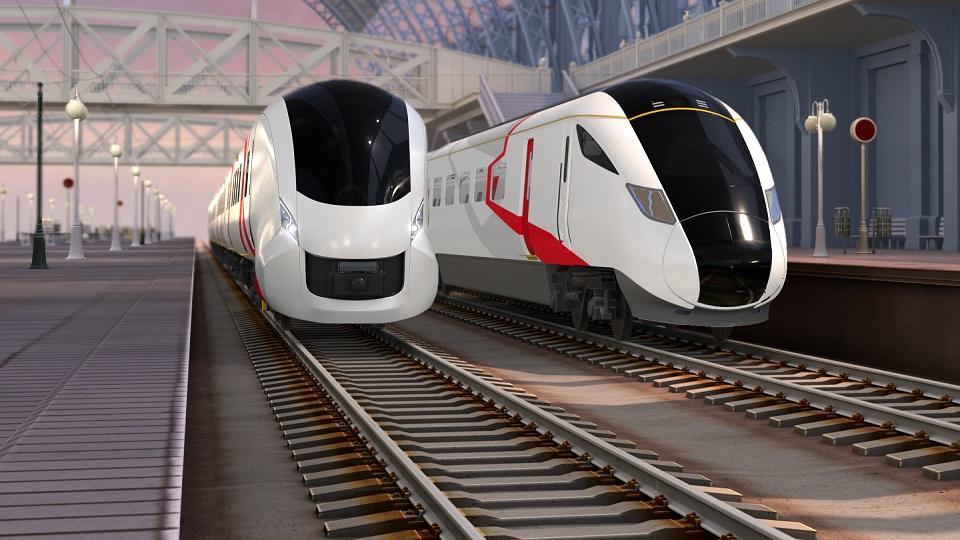R.E.News future Technology-Hitachi Rail’s Next-Gen Battery Innovation for Sustainable Trains
 13/01/25-FR-English-NL-footer
13/01/25-FR-English-NL-footer
Hitachi Rail : l'innovation de la batterie nouvelle génération pour des trains durables
 Image- Hitachi Rail
Image- Hitachi Rail
Dans une démarche ambitieuse vers des chemins de fer plus écologiques et plus efficaces, Hitachi Rail s'est associé à Innovate UK, à l'Université de Birmingham et à DB ESG pour innover dans la technologie des batteries de nouvelle génération. Cette collaboration public-privé vise à transformer les trains interurbains et de banlieue avec un nouveau bloc-batterie plus petit, plus léger et plus puissant que ses prédécesseurs.
La dernière conception de batterie promet une réduction de 40 % de la taille tout en offrant une amélioration de 22 % de la densité énergétique. Grâce à ces avancées, le projet vise non seulement à réduire les émissions, mais aussi à rendre les trains plus inclusifs et rentables, un pas en avant pour l'innovation britannique et la durabilité ferroviaire mondiale.
Au cœur de cette initiative révolutionnaire se trouve la chimie des batteries au lithium fer phosphate (LFP). En s'associant à Turntide Technologies, basée à Sunderland, Hitachi Rail intègre la technologie de pointe des batteries automobiles dans l'industrie ferroviaire. Cette innovation n'améliore pas seulement la puissance et l'efficacité ; elle répond également aux défis de conception critiques des trains modernes.
Une batterie plus petite et plus compacte permet une conception inclusive en permettant des planchers plus bas et un accès de plain-pied aux quais, rendant les trains plus accessibles aux passagers à mobilité réduite. De plus, le poids réduit simplifie les processus de maintenance et de modernisation, rationalise les opérations et améliore l'efficacité des trains dans leur ensemble.
L'expérience mondiale d'Hitachi Rail est un moteur clé de ce projet. S'appuyant sur des projets réussis comme le premier train de passagers à batterie au Japon et le train hybride à batterie Masaccio en Europe, Hitachi apporte son expertise internationale au Royaume-Uni. Ces réalisations passées jettent des bases solides pour adapter et optimiser la technologie des batteries afin de répondre aux besoins régionaux.
La collaboration s'étend également à la numérisation des solutions de batteries pour le rail. En utilisant des outils basés sur les données, Hitachi garantit une utilisation optimale des batteries, une réduction des émissions et une gestion du cycle de vie. Cette approche numérique ouvre la voie à des services innovants tels que la « batterie en tant que service », personnalisable en fonction des besoins spécifiques des clients.
DB ESG, un acteur de premier plan dans le domaine de la technologie ferroviaire, mène la charge dans la conception du nouveau boîtier de batterie. Cela comprend l'intégration de la protection contre les incendies, des systèmes de refroidissement et des connexions électriques. En s’appuyant sur les connaissances acquises lors des essais de batteries interurbaines d’Hitachi, DB ESG a optimisé l’enceinte des trains de banlieue à plancher surbaissé, où l’espace est un facteur essentiel.
Nick Goodhand, directeur général de DB ESG, a souligné les défis et les succès du projet : « L’abaissement du plancher a réduit de moitié l’espace disponible, mais nos optimisations de conception ont permis d’atteindre la capacité énergétique requise. » Cette intégration transparente d’une conception innovante et d’une application pratique témoigne des prouesses techniques du partenariat.
Le Birmingham Centre for Railway Research and Education (BCRRE) de l’Université de Birmingham joue un rôle essentiel dans la validation et l’optimisation de la technologie des batteries. Grâce à des simulations ferroviaires avancées, le BCRRE garantit que les performances de la batterie correspondent aux conditions réelles sur les lignes britanniques, y compris les chemins de fer exigeants du nord de l’Angleterre.
Le professeur Pietro Tricoli, chercheur principal au BCRRE, a déclaré : « Ce projet proposé comprend un programme de recherche complet visant à optimiser la conception et l’utilisation de la batterie lorsque le train circule dans des parties non électrifiées du réseau. Nous mettrons notre expertise en matière de simulations ferroviaires à profit pour étudier les itinéraires pour lesquels les batteries sont les plus efficaces pour remplacer les trains diesel. »
Cette collaboration améliore non seulement la technologie des batteries, mais renforce également les capacités de recherche de l’université, au bénéfice des futurs étudiants et diplômés dans ce domaine.
Avec un investissement total de 1,4 million de livres sterling, cette initiative de R&D illustre la puissance des partenariats public-privé. Le cofinancement d’Innovate UK garantit que le projet reste un modèle d’innovation dans le secteur des batteries en plein essor au Royaume-Uni. L’accent mis par le partenariat sur la durabilité, l’inclusivité et le développement des compétences démontre un engagement envers les avantages immédiats et à long terme pour l’industrie ferroviaire.
Koji Agatsuma, directeur technique des véhicules chez Hitachi Rail, a souligné l’impact plus large : « Cette amélioration continue signifie que nous travaillons toujours sur la prochaine génération de batteries plus petites et plus puissantes pour réduire les coûts des chemins de fer en annulant les dépenses d’infrastructure d’électrification ou en supprimant complètement les moteurs diesel. »
Les ambitions d’Hitachi Rail s’étendent au-delà des frontières du Royaume-Uni. Avec l’intention de déployer le train hybride à batterie EuroMasaccio en Europe d’ici 2026, l’entreprise est bien placée pour mener la transition mondiale vers des systèmes ferroviaires plus écologiques. L’intégration des systèmes de transport terrestre de Thales renforce encore les capacités d’Hitachi, permettant des innovations telles que la technologie de signalisation SelTrac™, qui prend déjà en charge plus d’un million de trajets de passagers par jour à Londres.
En combinant expertise technologique et engagement en faveur du développement durable, Hitachi Rail établit une nouvelle référence pour l’industrie ferroviaire dans le monde entier. Son approche, un mélange de recherche de pointe, de collaboration mondiale et d’innovation locale, illustre la manière dont les secteurs public et privé peuvent s’unir pour relever les défis du transport moderne.
Ce projet pionnier ne se contente pas de montrer ce qui est possible ; il met en évidence une feuille de route pour les avancées futures de la technologie ferroviaire. Avec des batteries plus légères et plus efficaces, des solutions de conception inclusives et une attention particulière portée au développement durable, Hitachi Rail et ses partenaires conduisent l’industrie ferroviaire vers un avenir plus propre et plus connecté.
En tirant parti de l’expertise mondiale, en favorisant l’innovation universitaire et en investissant dans les technologies de pointe, ce partenariat démontre que l’avenir du transport ferroviaire ne consiste pas seulement à se rendre du point A au point B, mais aussi à le faire de manière responsable, efficace et inclusive.
NJC.© Info Hitachi Rail
---------------------------------------------------------------------------------------------------------------
 13/01/25-English
13/01/25-English
Hitachi Rail’s Next-Gen Battery Innovation for Sustainable Trains
 Image- Hitachi Rail
Image- Hitachi Rail
In an ambitious move towards greener, more efficient railways, Hitachi Rail has teamed up with Innovate UK, the University of Birmingham, and DB ESG to pioneer next-generation battery technology. This public-private collaboration aims to transform intercity and commuter trains with a new battery pack that is smaller, lighter, and more powerful than its predecessors.
The latest battery design promises a 40% reduction in size while delivering a 22% improvement in energy density. With these advancements, the project seeks not only to slash emissions but also to make trains more inclusive and cost-effective—a step forward for British innovation and global rail sustainability.
At the heart of this ground-breaking initiative lies Lithium Iron Phosphate (LFP) battery chemistry. By partnering with Sunderland-based Turntide Technologies, Hitachi Rail integrates cutting-edge automotive battery technology into the rail industry. This innovation doesn’t just improve power and efficiency; it also addresses critical design challenges for modern trains.
A smaller, more compact battery enables inclusive design by allowing for lower floors and level access at platforms, making trains more accessible to passengers with limited mobility. Furthermore, the reduced weight simplifies maintenance and retrofitting processes, streamlining operations and enhancing train efficiency across the board.
Hitachi Rail’s global experience is a key driver of this project. Drawing from successful ventures like Japan’s first passenger battery train and Europe’s Masaccio battery hybrid train, Hitachi is bringing its international expertise to the UK. These past achievements lay a solid foundation for adapting and optimising battery technology to meet regional needs.
The collaboration also extends to digitising battery solutions for rail. By utilising data-driven tools, Hitachi ensures optimal battery use, emissions reduction, and life-cycle management. This digital approach opens the door to innovative services such as “battery as a service,” customisable to specific customer needs.
DB ESG, a prominent player in railway technology, is leading the charge in designing the new battery enclosure. This includes integrating fire protection, cooling systems, and electrical connections. By building on insights gained from Hitachi’s intercity battery trials, DB ESG has optimised the enclosure for low-floor commuter trains, where space is a premium.
Nick Goodhand, Managing Director at DB ESG, highlighted the challenges and triumphs of the project: “Lowering the floor has halved the available space, but our design optimisations have enabled the required power capacity to be achieved.” This seamless integration of innovative design and practical application is a testament to the partnership’s engineering prowess.
The University of Birmingham’s Birmingham Centre for Railway Research and Education (BCRRE) plays a pivotal role in validating and optimising the battery technology. Using advanced railway simulations, BCRRE ensures the battery’s performance aligns with real-world conditions on UK routes, including the demanding railways of Northern England.
Professor Pietro Tricoli, a lead researcher at BCRRE, remarked: “This proposed project includes a comprehensive research programme aimed at optimising the design and usage of the battery when the train travels in non-electrified parts of the network. We will provide our expertise with railway simulations to investigate the routes for which batteries are the most effective in replacing diesel trains.”
This collaboration not only enhances battery technology but also strengthens the university’s research capabilities, benefiting future students and graduates in the field.
With a total investment of £1.4 million, this R&D initiative exemplifies the power of public-private partnerships. Innovate UK’s co-funding ensures the project remains a beacon of innovation in the UK’s burgeoning battery sector. The partnership’s focus on sustainability, inclusivity, and skills development demonstrates a commitment to both immediate and long-term benefits for the rail industry.
Koji Agatsuma, Chief Technology Officer Vehicles at Hitachi Rail, underscored the broader impact: “This continuous improvement means we are always working on the next generation of smaller and more powerful batteries to reduce cost on railways by negating electrification infrastructure spend or removing diesel engines entirely.”
Hitachi Rail’s ambitions extend beyond UK borders. With plans to roll out the EuroMasaccio battery hybrid train in Europe by 2026, the company is well-positioned to lead the global shift towards greener rail systems. The integration of Thales’ Ground Transportation Systems further strengthens Hitachi’s capabilities, enabling innovations like SelTrac™ signalling technology, which already supports over one million passenger journeys daily in London.
By combining technological expertise with a commitment to sustainability, Hitachi Rail is setting a new benchmark for the rail industry worldwide. Their approach—a blend of cutting-edge research, global collaboration, and local innovation—illustrates how public and private sectors can unite to tackle the challenges of modern transport.
This pioneering project doesn’t just showcase what’s possible; it highlights a roadmap for future advancements in rail technology. With lighter, more efficient batteries, inclusive design solutions, and a focus on sustainability, Hitachi Rail and its partners are driving the rail industry into a cleaner, more connected future.
By leveraging global expertise, fostering academic innovation, and investing in cutting-edge technology, this partnership demonstrates that the future of rail isn’t just about getting from point A to point B—it’s about doing so responsibly, efficiently, and inclusively.
NJC.© Info Hitachi Rail
---------------------------------------------------------------------------------------------------------------
 13/01/25-NL
13/01/25-NL
Hitachi Rail's Next-Gen Battery Innovation voor duurzame treinen
 Image- Hitachi Rail
Image- Hitachi Rail
In een ambitieuze stap richting groenere, efficiëntere spoorwegen is Hitachi Rail een samenwerking aangegaan met Innovate UK, de Universiteit van Birmingham en DB ESG om een pionier te zijn in next-generation batterijtechnologie. Deze publiek-private samenwerking is gericht op het transformeren van intercity- en forenzentreinen met een nieuw batterijpakket dat kleiner, lichter en krachtiger is dan zijn voorgangers.
Het nieuwste batterijontwerp belooft een 40% kleinere omvang en een verbetering van 22% in energiedichtheid. Met deze ontwikkelingen streeft het project er niet alleen naar om de uitstoot te verminderen, maar ook om treinen inclusiever en kosteneffectiever te maken - een stap voorwaarts voor Britse innovatie en wereldwijde duurzaamheid van het spoor.
De kern van dit baanbrekende initiatief ligt in de batterijchemie van lithium-ijzerfosfaat (LFP). Door samen te werken met Turntide Technologies uit Sunderland integreert Hitachi Rail geavanceerde autobatterijtechnologie in de spoorwegindustrie. Deze innovatie verbetert niet alleen het vermogen en de efficiëntie; het pakt ook kritieke ontwerpuitdagingen voor moderne treinen aan.
Een kleinere, compactere batterij maakt inclusief ontwerp mogelijk door lagere verdiepingen en vlakke toegang tot perrons mogelijk te maken, waardoor treinen toegankelijker worden voor passagiers met beperkte mobiliteit. Bovendien vereenvoudigt het verminderde gewicht onderhouds- en retrofitprocessen, stroomlijnt de bedrijfsvoering en verbetert de efficiëntie van de trein over de hele linie.
De wereldwijde ervaring van Hitachi Rail is een belangrijke drijfveer voor dit project. Hitachi brengt zijn internationale expertise naar het VK, voortbouwend op succesvolle ondernemingen zoals de eerste Japanse passagierstrein met batterij en de Masaccio hybride trein met batterij in Europa. Deze eerdere prestaties vormen een solide basis voor het aanpassen en optimaliseren van batterijtechnologie om aan regionale behoeften te voldoen.
De samenwerking strekt zich ook uit tot het digitaliseren van batterijoplossingen voor het spoor. Door gebruik te maken van datagestuurde tools, zorgt Hitachi voor optimaal batterijgebruik, emissiereductie en levenscyclusbeheer. Deze digitale aanpak opent de deur naar innovatieve diensten zoals "batterij als service", aanpasbaar aan specifieke klantbehoeften.
DB ESG, een vooraanstaande speler in spoorwegtechnologie, neemt het voortouw bij het ontwerpen van de nieuwe batterijbehuizing. Dit omvat het integreren van brandbeveiliging, koelsystemen en elektrische verbindingen. Door voort te bouwen op inzichten die zijn verkregen uit Hitachi's intercitybatterijproeven, heeft DB ESG de behuizing geoptimaliseerd voor forenzentreinen met een lage vloer, waar ruimte schaars is.
Nick Goodhand, Managing Director bij DB ESG, benadrukte de uitdagingen en triomfen van het project: "Door de vloer te verlagen is de beschikbare ruimte gehalveerd, maar onze ontwerpoptimalisaties hebben het vereiste vermogen mogelijk gemaakt." Deze naadloze integratie van innovatief ontwerp en praktische toepassing is een bewijs van de technische bekwaamheid van het partnerschap.
Het Birmingham Centre for Railway Research and Education (BCRRE) van de Universiteit van Birmingham speelt een cruciale rol bij het valideren en optimaliseren van de batterijtechnologie. Met behulp van geavanceerde spoorwegsimulaties zorgt BCRRE ervoor dat de prestaties van de batterij aansluiten op de echte omstandigheden op Britse routes, inclusief de veeleisende spoorwegen van Noord-Engeland.
Professor Pietro Tricoli, een hoofdonderzoeker bij BCRRE, merkte op: "Dit voorgestelde project omvat een uitgebreid onderzoeksprogramma gericht op het optimaliseren van het ontwerp en gebruik van de batterij wanneer de trein door niet-geëlektrificeerde delen van het netwerk rijdt. We zullen onze expertise inzetten met spoorwegsimulaties om de routes te onderzoeken waarvoor batterijen het meest effectief zijn bij het vervangen van dieseltreinen."
Deze samenwerking verbetert niet alleen de batterijtechnologie, maar versterkt ook de onderzoekscapaciteiten van de universiteit, wat toekomstige studenten en afgestudeerden in het veld ten goede komt.
Met een totale investering van £ 1,4 miljoen is dit R&D-initiatief een voorbeeld van de kracht van publiek-private partnerschappen. De cofinanciering van Innovate UK zorgt ervoor dat het project een baken van innovatie blijft in de opkomende batterijsector van het VK. De focus van het partnerschap op duurzaamheid, inclusiviteit en vaardigheidsontwikkeling toont een toewijding aan zowel directe als langetermijnvoordelen voor de spoorwegindustrie.
Koji Agatsuma, Chief Technology Officer Vehicles bij Hitachi Rail, benadrukte de bredere impact: "Deze voortdurende verbetering betekent dat we altijd werken aan de volgende generatie kleinere en krachtigere batterijen om de kosten op het spoor te verlagen door de uitgaven voor elektrificatie-infrastructuur te elimineren of dieselmotoren volledig te verwijderen."
De ambities van Hitachi Rail reiken verder dan de grenzen van het Verenigd Koninkrijk. Met plannen om de EuroMasaccio batterijhybridetrein in 2026 in Europa uit te rollen, is het bedrijf goed gepositioneerd om de wereldwijde verschuiving naar groenere spoorwegsystemen te leiden. De integratie van Thales' Ground Transportation Systems versterkt de mogelijkheden van Hitachi verder, waardoor innovaties zoals SelTrac™-signaleringstechnologie mogelijk worden, die al dagelijks meer dan een miljoen passagiersreizen in Londen ondersteunt.
Door technologische expertise te combineren met een toewijding aan duurzaamheid, zet Hitachi Rail een nieuwe maatstaf voor de spoorwegindustrie wereldwijd. Hun aanpak - een mix van baanbrekend onderzoek, wereldwijde samenwerking en lokale innovatie - illustreert hoe de publieke en private sector zich kunnen verenigen om de uitdagingen van modern transport aan te pakken.
Dit baanbrekende project laat niet alleen zien wat mogelijk is; het benadrukt ook een routekaart voor toekomstige ontwikkelingen in spoorwegtechnologie. Met lichtere, efficiëntere batterijen, inclusieve ontwerpoplossingen en een focus op duurzaamheid, leiden Hitachi Rail en haar partners de spoorwegindustrie naar een schonere, meer verbonden toekomst.
Door wereldwijde expertise te benutten, academische innovatie te bevorderen en te investeren in geavanceerde technologie, laat dit partnerschap zien dat de toekomst van het spoor niet alleen draait om van punt A naar punt B te komen, maar om dit op een verantwoorde, efficiënte en inclusieve manier te doen.
NJC.© Info Hitachi Rail
-----------------------------------------------------------------------------------------------------------------
Date de dernière mise à jour : 10/01/2025
















